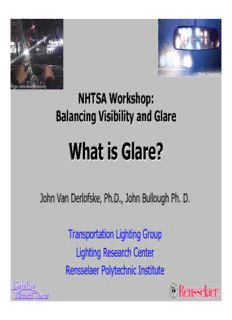
What is Glare? PDF
Preview What is Glare?
Photo: Tracy Kroll Photo: www.seniordrivers.org NNHHTTSSAA WWoorrkksshhoopp:: BBaallaanncciinngg VViissiibbiilliittyy aanndd GGllaarree WWhhaatt iiss GGllaarree?? John Van Derlofske, Ph.D., John Bullough Ph. D. Transportation Lighting Group Lighting Research Center Rensselaer Polytechnic Institute WWhhaatt iiss ""ggllaarree""?? • "Dictionary" definition: A harsh uncomfortably bright light <the glare of a neon sign> <the glare of publicity>; especially: painfully bright sunlight • Glare occurs in two ways: – Too much light Photo: www.getten.net – Luminance range is too large • Effects of glare: – Photobiological damage: not considered here – Disability glare: reduction in visibility – Discomfort glare: annoying or painful sensation – Recovery (readaptation):visual performance returning to its initial state DDiissaabbiilliittyy ggllaarree • Reduction in visibility can be attributed to light scatter in the eye (Stiles, 1929) • The magnitude of disability glare can be estimated by the veiling luminance L v n E E =illuminance from ith glare i ∑ L = 9.2 i source (lx) v ( ) θ θ +1.5 θ=angle between the target i=1 i i i and ith glare source (deg) (Based on Fry, 1954; other formulae from Stiles-Holladay, Adrian, Vos) DDiissaabbiilliittyy ggllaarree • This effect is exhibited in luminance contrast C: L =target L − L (L +L )−(L +L ) L −L t C = t b C= t v b v = t b luminance L L +L L +L L =background b b v b v b (IESNA, 2000) luminance Photo: www.fostercity.org DDiissccoommffoorrtt ggllaarree • A subjective feeling of annoyance caused by high luminance in the field of view DeBoer Scale Photo: www.campstevens.org Rating Qualifier 1 Unbearable 2 3 Disturbing 4 a c 5 Just Acceptable a. ri o 6 t s hi w. 7 Satisfactory w w : 8 o t o 9 Just Noticable h P Photo: www.photodiary.org (De Boer, 1967) (Schmidt-Clausen and Bindels, 1974) RReeccoovveerryy ((RReeaaddaappttaattiioonn)) • Readaptation to lower light levels after glare exposure takes time • Visual performance is reduced during this recovery period Photo:www.fostercity.org (Boynton and Miller, 1963) (Baker, 1963) (See also Higgins and White, 1999; Lehnert, 2001; Schieber) WWhhaatt ddoo wwee kknnooww GGllaarree aanndd vviissuuaall ppeerrffoorrmmaannccee • Parameters that affect visual performance: (e.g., Mace et al., 2001) – Glare parameters: • illuminance at the eye (Schmidt-Clausen and Bindels, 1974; Flannagan et al., 1996; Bullough et al., 2003 and glare formulae) • angle of the glare source (Fry, 1954; Fu, 2001 and glare formulae) • luminance/size (Flannagan, 1999; Bullough et al., 2003) • spectral power distribution (Flannagan, 1999; Bullough et al., 2002, 2003) Photo: www.surgicaleyes.org • duration of exposure (Fry, 1973) WWhhaatt ddoo wwee kknnooww GGllaarree aanndd vviissuuaall ppeerrffoorrmmaannccee • Parameters that affect visual performance: (e.g., Mace et al., 2001) – Environmental parameters: • ambient conditions (Andre and Owens, 1999; Akashi et al., 2003; Carlson and Urbanik, 2004) • complexity/difficulty of location (Theeuwes and Alferdinck, 1996; Bullough et al., 2003) – Observer parameters: • age, visual health (Campbell et al., 1998; Higgins and White, 1999; Schmitz et al., 2000; Peli, 2002; McGwin et al., 2003; Schieber) Photo: www.surgicaleyes.org IIlllluummiinnaannccee aatt tthhee eeyyee • Increased glare illuminance results in increased veiling luminance, which decreases luminance contrast (Stiles, 1929) (Stiles, 1929) (See also Flannagan et al., 1996; Flannagan, 1999; Ranney et al., 1999, 2000; Bullough et al., 2002, 2003 and existing glare formulae) LLuummiinnaannccee//ssiizzee • Size of glare source (0.3o or 0.6o) had no impact on detection of target (Flannagan, 1999) (Flannagan, 1999) (See also Bullough et al., 2003; Van Derlofske et al., 2004)
Description: